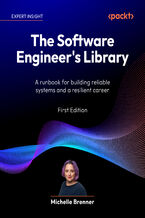Technology Operating Models for Cloud and Edge. Create your purpose-built distributed operating model for public, hybrid, multicloud, and edge Ahilan Ponnusamy, Andreas Spanner, Mirco Hering, Vincent Caldeira, Neetan Chopra




- Autorzy:
- Ahilan Ponnusamy, Andreas Spanner, Mirco Hering, Vincent Caldeira, Neetan Chopra
- Wydawnictwo:
- Packt Publishing
- Ocena:
- Stron:
- 228
- Dostępne formaty:
-
PDFePub
Opis
książki
:
Technology Operating Models for Cloud and Edge. Create your purpose-built distributed operating model for public, hybrid, multicloud, and edge
This book provides a practical way to build a strategy-aligned operating model while considering various related factors such as culture, leadership, team structures, metrics, intrinsic motivators, team incentives, tenant experience, platform engineering, operations, open source, and technology choices. Throughout the chapters, you’ll discover how single, hybrid, or multicloud architectures, security models, automation, application development, workload deployments, and application modernization can be reutilized for edge workloads to help you build a secure yet flexible technology operating model. The book also includes a case study which will walk you through the operating model build process in a step-by-step way.
By the end of this book, you’ll be able to build your own fit-for-purpose distributed technology operating model for your organization in an open culture way.
Wybrane bestsellery
Packt Publishing - inne książki
Dzięki opcji "Druk na żądanie" do sprzedaży wracają tytuły Grupy Helion, które cieszyły sie dużym zainteresowaniem, a których nakład został wyprzedany.
Dla naszych Czytelników wydrukowaliśmy dodatkową pulę egzemplarzy w technice druku cyfrowego.
Co powinieneś wiedzieć o usłudze "Druk na żądanie":
- usługa obejmuje tylko widoczną poniżej listę tytułów, którą na bieżąco aktualizujemy;
- cena książki może być wyższa od początkowej ceny detalicznej, co jest spowodowane kosztami druku cyfrowego (wyższymi niż koszty tradycyjnego druku offsetowego). Obowiązująca cena jest zawsze podawana na stronie WWW książki;
- zawartość książki wraz z dodatkami (płyta CD, DVD) odpowiada jej pierwotnemu wydaniu i jest w pełni komplementarna;
- usługa nie obejmuje książek w kolorze.
Masz pytanie o konkretny tytuł? Napisz do nas: sklep@helion.pl
Książka drukowana
































Oceny i opinie klientów: Technology Operating Models for Cloud and Edge. Create your purpose-built distributed operating model for public, hybrid, multicloud, and edge Ahilan Ponnusamy, Andreas Spanner, Mirco Hering, Vincent Caldeira, Neetan Chopra
(0)